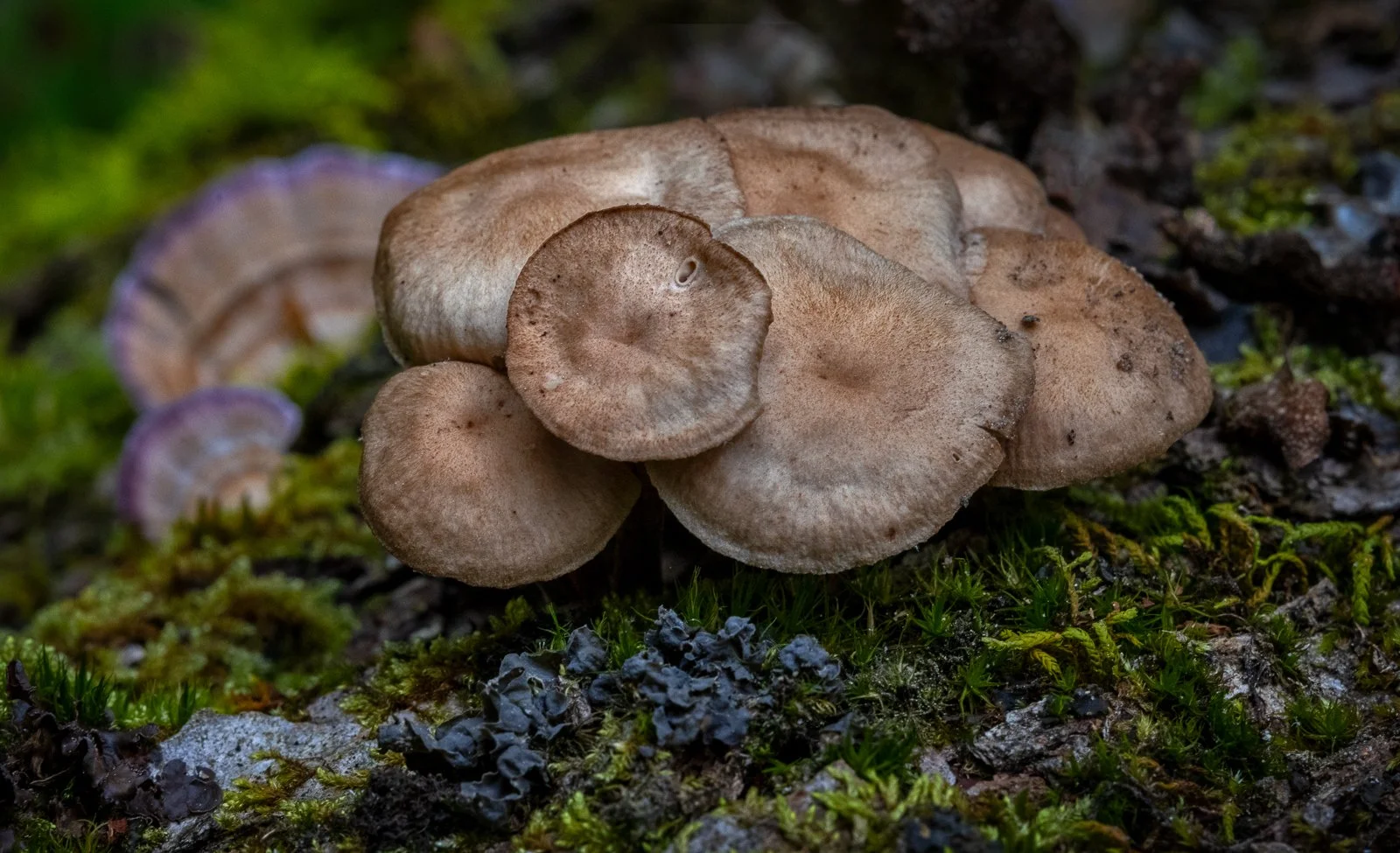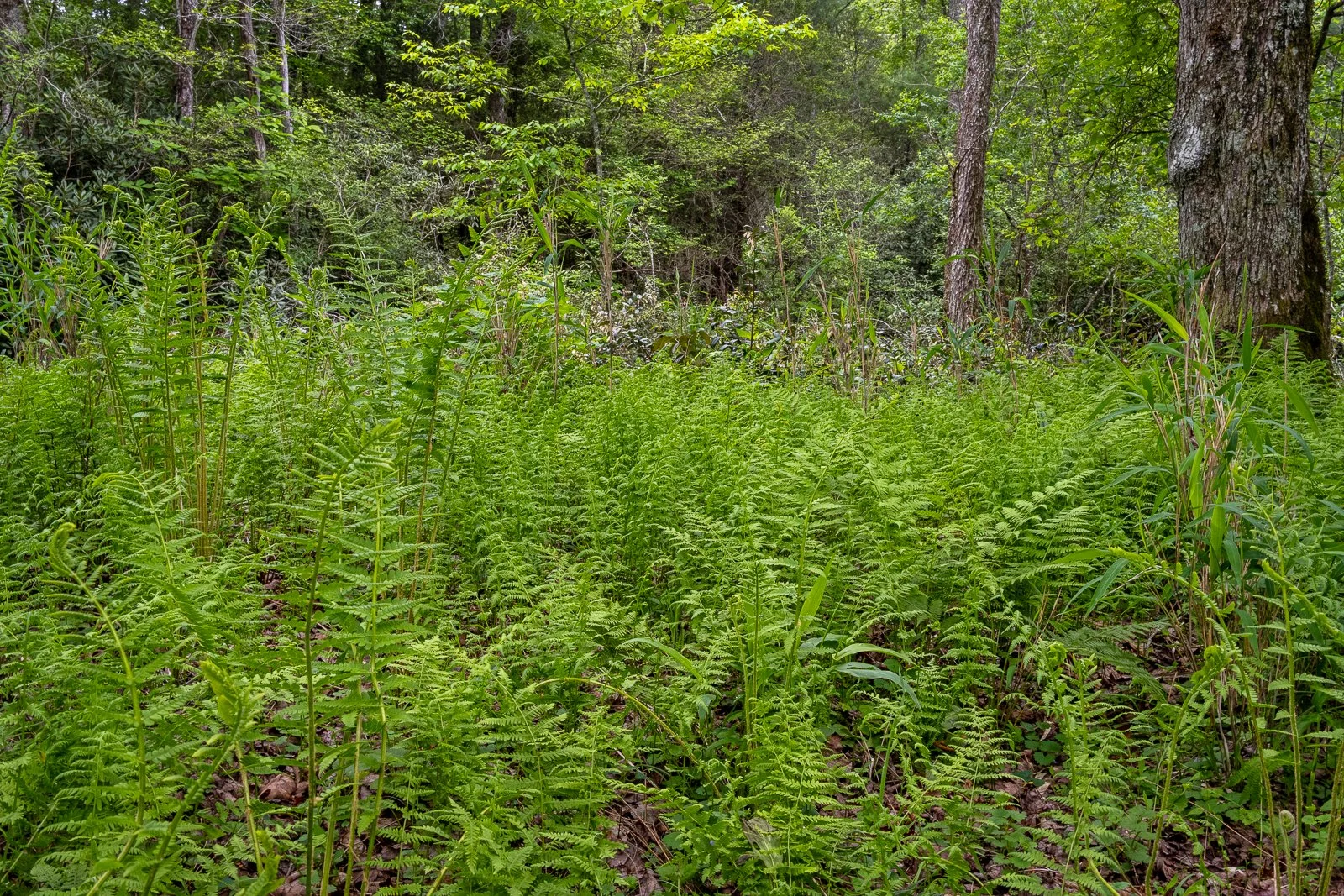Little River Wetlands–A Naturally Flowing River and Biodiverse Wetlands
Tree With Explosion of Life, Little River Wetlands
A week ago, my husband and I visited the Little River Wetlands, a property recently acquired by Conserving Carolina that is not yet open to the public. The rickety bridge that we were supposed to cross had been pulled out of the river, probably by the Army Corps of Engineers, and lay on the side of the bank. We walked down the edge of the stream to explore a small part of the 27-acre wetlands and noted tracks made by big equipment. Cleanup efforts were ongoing by the side of the road. The ground the machinery traversed on the way to the river had stripped the vegetation in that section. Fortunately, the rest of the banks had been left alone. I was delighted to see so many ferns and mosses along the river, and the explosion of life on this tree trunk was unlike what I typically encounter along other streams and rivers in the area. Conserving Carolina purchased this land in February 2023 to preserve the in tact natural floodplain. There are numerous oxbows and the water is allowed to go where it wants, while the land absorbs floodwaters and allows them to naturally disperse. The fact that the hasn’t been channelized has helped maintain the biodiversity of lifeforms and the water quality.
Above are two photos showing how the river follows its natural course. There are oxbows and the stream appeared quite clean. Ferns, rhododendrons, trees, and other vegetation cover the riparian banks. After Helene, so many river banks that had narrow rows of trees were stripped causing severe erosion. Here, the water must have risen high enough to destroy the bridge, but the banks though slightly eroded were in much better shape.
Banks of the Little River Wetlands
It felt magical walking around in this relatively undisturbed land, which was purchased to help water quality and as a buffer to a rare Appalachian mountain bog nearby that is slated to become a National Wildlife Refuge. Protecting areas like this help maintain the biodiversity and health of local ecosystems, especially the ones downstream, as well as protecting habitable land nearby by reducing the severity of flooding.
Vegetation Growing to the Edge of the River
Even though the bank was undercut beneath this clump of vegetation, the plants were still thriving and they protected the surrounding land from being eroded.
Tiny Bluet
This little bluet was right on the edge of the banks along a small tributary. There were several more of these delicate flowers nearby. Almost every square inch was filled with living matter.
Above is another photograph of the naturally meandering river and the one on the right shows some huge ferns. The primeval beauty of the area filled me with hope that nature, when left alone, is more resilient and can recover more quickly than when people try to control rivers by channelizing and diking them and stripping their banks of vegetation.
Fungi Decomposing a Fallen Log
Nature is very adept at dealing with fallen trees, especially when areas are left in tact and there is enough vegetation to break the wind and absorb rising waters. Fungi feed on dead trees and break them down, while simultaneously providing energy and nutrients to surviving plants and other lifeforms.
Living Bark, Little River Wetlands
It was astonishing to see how diverse the lifeforms were on tree trunks we encountered. The ferns and mosses may derive some nutrients from the trees, but the trees don’t gain any advantage nor do the ferns and mosses harm the trees. They exist in a symbiotic relationship known as commensalism. Lifeforms and humans can’t always help each other, but at the very least being non-harming is a goal to strive for. The lack of care for other life forms in our society right now is cause for great concern.
Fern Explosion
The ferns were thick on the ground, in some places covering almost square inch. They looked very healthy and some were quite large.
These cinnamon ferns were very impressive. They grow in damp, forested areas, especially along streams. The outer green ferns are sterile, but the inner cinnamon colored ones are spore-bearing. They are symbolic of resilience, because of their ability to adapt to changing conditions, as well as new beginnings. Below is a closeup of the spore-bearing fronds that are in the center. They grow in the middle to ensure their spores are protected. The intelligence of nature never ceases to amaze me, and this is a great example of how sheltering life in all its diversity ensures its continuity.
Spore-Bearing Fronds of The Cinnamon Fern
The white fuzzy substance around the central fronds is spore-bearing, unless it is on the leaves of the ferns. These ferns clearly exhibit a large quantity of spores.
Little River Wetlands Eight Months After Helene
Though this area was impacted by Helene, as were most areas with rivers or streams in Western North Carolina, it will undoubtedly come back sooner since nature is being allowed to react naturally. Though tree branches were broken, the banks were eroded, and the bridge likely fell in before it was removed, overall the area survived the 1 in 1,000 year storm relatively well. I look forward to returning to this beautiful area and exploring more of the land. Thanks to Conserving Carolina for having the foresight to purchase this land. It will be so helpful in minimizing the impact of future storms and it will contribute to the flourishing of life in this region.















